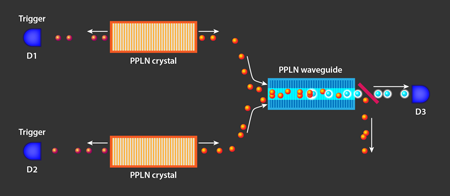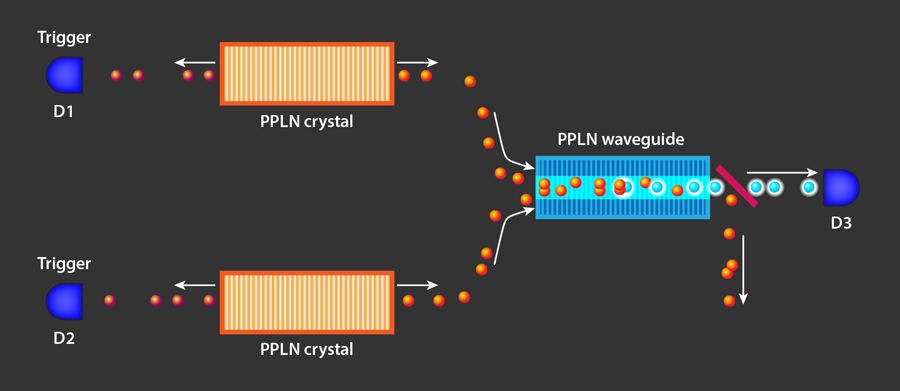Two Photons into One
Quantum information science opens new opportunities for future information-processing architectures that exploit the fundamental properties of quantum mechanics. Quantum information processing (QIP) has two essential ingredients: elementary quantum logic gates and remote communication of quantum information. Photons are particularly suitable as quantum information carriers, thanks to their long coherence times and the maturity of existing optical communication techniques, and quantum information encoded in single photons is a crucial ingredient for quantum cryptography, entanglement of distant nodes in a quantum network, and quantum sensing [1]. For photonic quantum logic gates, however, a major hurdle is that individual photons do not interact in ordinary linear media. QIP researchers have long sought deterministic photonic quantum logic gates using individual photons interacting in nonlinear media. Thiago Guerreiro and colleagues from the University of Geneva, Switzerland, and Stanford University, California, have used an optical waveguide to observe, for the first time, the nonlinear interaction of individual pairs of telecommunications-wavelength photons [2]. Although the current process is probably too inefficient to be of immediate practical use, these findings may open a route towards integrated QIP platforms.
Most demonstrations of photon-photon interaction have exploited the nonlinear response of atoms in a gas, generally at very low temperatures [3]. In such processes, photons need to be on resonance with the transition lines of atoms (or artificial atoms in solid-state systems [3]), so operation is usually restricted to a narrow frequency range. Alternatively, optical nonlinear processes can occur in solid-state nonlinear materials, which may enable a more compact platform and the capability of operating at room temperature. The large bandwidth of these materials allows interactions between ultrafast photon pulses (which are built up of many frequencies), thus leading to high data rates. They can also be optimized for operation at a chosen wavelength, using a technique called periodic poling in which the material polarization is varied along the propagation direction.
Since the early 1990s, researchers have studied frequency conversion of quantum signals via so-called parametric processes in such nonlinear materials [4]. Yet these quantum frequency-conversion techniques require that a quantum signal interact with a strong classical field to overcome the weak nonlinearity. Recently, spontaneous parametric down-conversion (SPDC) of a single photon into two lower-energy photons in a solid-state system was experimentally demonstrated [5]. The direct observation of the inverse process—two single photons interacting and merging into a higher energy photon—remained elusive. Such interactions between two quantum mechanical objects are of particular interest because they can provide the underlying physical processes in photonic quantum logic gates, which are potential building blocks for compact all-optical QIP platforms operating at room temperature, as well as for fundamental quantum measurements [6].
Guerreiro and colleagues used a periodically poled lithium niobate (PPLN) waveguide to promote photon-photon interactions, and they demonstrated the production of a single, higher-energy photon via the nonlinear interaction of two telecommunications-wavelength single photons. Compared to bulk nonlinear materials, the waveguide allows a longer photon-photon interaction length and thus a higher conversion efficiency. The waveguide also confines both single photons to the same small region in space, further enhancing the interaction. Nonlinear waveguides have successfully produced high-flux two- and multi-photon entangled states [5,7], and Guerreiro and colleagues previously used such a structure to induce a single photon to interact with a weak classical field [8]. Now they show, for the first time, the interaction of two photons that are individually identified.
To document the desired photon-photon interaction, Guerreiro and colleagues first produced two “heralded” single photons using two PPLN bulk crystals. They pumped each PPLN bulk crystal with -picosecond pulses with a wavelength of nanometer (nm). Occasionally, one pump photon was down converted into two single photons at nm and nm, respectively. The detection of an -nm photon uniquely heralds a single photon at nm. Guerreiro and colleagues employed two single-photon detectors (D1 and D2 in Fig. 1) at nm to herald two single photons near nm, which were then combined into a -cm-long PPLN waveguide. With very low probability, the nonlinear interaction inside the PPLN waveguide converts the two single photons into a shorter wavelength photon at nm.
To verify the photon-photon interaction, Guerreiro and colleagues first separated out the up-converted -nm photons and guided them to a third single-photon detector (D3 in Fig. 1). A threefold coincidence registered by D1, D2, and D3 could be evidence for interaction, but the background dark current of these detectors could also give detection “clicks” even with no photons present. Consequently, Guerreiro and colleagues had to rule out the threefold coincidences originating from dark clicks. They measured the number of coincidences to be more than 7 standard deviations above the dark-current background, thus providing convincing evidence of the photon-photon interaction inside their PPLN waveguide.
The technique developed by Guerreiro and colleagues could have significant impact for QIP. Potential applications include device-independent quantum key distribution, whose security does not rest upon trusting the quantum signal sources and measurement apparatus, as well as faithful entanglement swapping, which is an essential element in quantum networks [9]. Such photon-photon interactions could also generate novel quantum states that have not been produced before, thus enriching the accessible resources for QIP. However, although the use of the PPLN waveguide successfully enabled direct observation of interactions at the single-photon level, the overall efficiency of —owing to the intrinsic weak nonlinearity of such materials—is in sharp contrast to the high efficiencies achievable in atomic systems [3]. Already, though, Guerreiro and colleagues’ experiment represents an important step towards developing broadband integrated QIP devices operating at room temperature. More importantly, their work clearly calls for future research in quantum nonlinear optics, and proposals for utilizing new materials as solid-state platforms for photon-photon interactions are on the rise [10]. With all these exciting developments, we can expect that the combined efforts in quantum nonlinear optics and material science could yield a fascinating leap in our future technology.
This research is published in Physical Review Letters.
Acknowledgments
Z. Zhang acknowledges illuminating discussions with J.H. Shapiro, F.N.C. Wong, and C. Lee.
References
- N. Gisin, G. Ribordy, W. Tittel, and H. Zbinden, “Quantum Cryptography,” Rev. Mod. Phys. 74, 145 (2002); L.-M. Duan, M. D. Lukin, J. I. Cirac, and P. Zoller, “Long-Distance Quantum Communication with Atomic Ensembles and Linear Optics,” Nature 414, 413 (2001); V. Giovannetti, S. Lloyd, and L. Maccone, “Quantum Metrology,” Phys. Rev. Lett. 96, 010401 (2006)
- T. Guerreiro, A. Martin, B. Sanguinetti, J. S. Pelc, C. Langrock, M. M. Fejer, N. Gisin, H. Zbinden, N. Sangouard, and R. T. Thew, “Nonlinear Interaction between Single Photons,” Phys. Rev. Lett. 113, 173601 (2014)
- O. Firstenberg, T. Peyronel, Q.-Y. Liang, A. V. Gorshkov, M. D. Lukin, and V. Vuletić, “Attractive Photons in a Quantum Nonlinear Medium,” Nature 502, 71 (2013); D. Englund, A. Faraon, I. Fushman, N. Stoltz, P. Petroff, and J. Vučković, “Controlling Cavity Reflectivity with a Single Quantum Dot,” 450, 857 (2007); See also D. E. Chang, V. Vuletić, and M. D. Lukin, “Quantum Nonlinear Optics—Photon by Photon,” Nature Photon. 8, 685 (2014)
- J. Huang and P. Kumar, “Observation of Quantum Frequency Conversion,” Phys. Rev. Lett. 68, 2153 (1992)
- L. K. Shalm, D. R. Hamel, Z. Yan, C. Simon, K. J. Resch, and T. Jennewein, “Three-Photon Energy–Time Entanglement,” Nature Phys. 9, 19 (2013); D. R. Hamel, L. K. Shalm, H. Hübel, A. J. Miller, F. Marsili, V. B. Verma, R. P. Mirin, S. W. Nam, K. J. Resch, and T. Jennewein, “Direct Generation of Three-Photon Polarization Entanglement,” Nature Photon. 8, 801 (2014)
- Y.-H. Kim, S. P. Kulik, and Y. Shih, “Quantum Teleportation of a Polarization State with a Complete Bell State Measurement,” Phys. Rev. Lett. 86, 1370 (2001)
- T. Zhong, F. N. C. Wong, A. Restelli, and J. C. Bienfang, “Efficient Single-Spatial-Mode Periodically-Poled KTiOPO Waveguide Source for High-Dimensional Entanglement-Based Quantum Key Distribution,” Opt. Express 20, 26868 (2012)
- T. Guerreiro, E. Pomarico, B. Sanguinetti, N. Sangouard, J. S. Pelc, C. Langrock, M. M. Fejer, H. Zbinden, R. T. Thew, and N. Gisin, “Interaction of Independent Single Photons based on Integrated Nonlinear Optics,” Nature Commun. 4, 2324 (2013)
- N. Sangouard, B. Sanguinetti, N. Curtz, N. Gisin, R. Thew, and H. Zbinden, “Faithful Entanglement Swapping Based on Sum-Frequency Generation,” Phys. Rev. Lett. 106, 120403 (2011)
- M. Gullans, D. E. Chang, F. H. L. Koppens, F. J. García de Abajo, and M. D. Lukin, “Single-Photon Nonlinear Optics with Graphene Plasmons,” Phys. Rev. Lett. 111, 247401 (2013)





